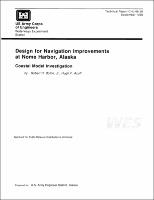Please use this identifier to cite or link to this item:
https://hdl.handle.net/11681/7378Full metadata record
| DC Field | Value | Language |
|---|---|---|
| dc.contributor.author | Bottin, Robert R. | - |
| dc.contributor.author | Acuff, Hugh F. | - |
| dc.date.accessioned | 2016-05-06T14:32:14Z | - |
| dc.date.available | 2016-05-06T14:32:14Z | - |
| dc.date.issued | 1998-09 | - |
| dc.identifier.uri | http://hdl.handle.net/11681/7378 | - |
| dc.description | Technical report | - |
| dc.description | A 1:90-scale (undistorted) three-dimensional coastal hydraulic model was used to investigate the design of proposed navigation improvements at Nome Harbor, Alaska with respect to wave, current and shoaling conditions at the site. The model reproduced about 3,350 m (11,000 ft) of the Alaskan shoreline, the existing harbor and lower reaches of the Snake River, and sufficient offshore bathymetry in the Norton Sound to permit generation of the required experimental waves. The model was used to determine the impacts of a new entrance channel on wave-induced current patterns and magnitudes, sediment transport patterns, and wave conditions in the new channel and harbor area, as well as to optimize the lengths and alignments of new breakwaters and causeway extensions. A 24.4-m-long (90-ft-long) unidirectional spectral wave generator, and automated data acquisition and control system and a crushed coal tracer material were utilized in model operation. It was concluded from study results that: a. Existing conditions are characterized by rough and turbulent wave conditions in the existing entrance. Very confused wave patterns were observed in the entrance due to wave energy reflected off the vertical walls lining the entrance. Wave heights in excess of 1.5 m (5 ft) were obtained in the entrance for typical storm conditions; and wave heights of almost 3.7 m (12 ft) were obtained in the entrance for 50-year storm wave conditions with extreme high-water level (4 m (+13 ft)). b. Wave conditions along the vertical-faced causeway docks were excessive for existing conditions. Wave heights in excess of 3.7 and 2-7 m (12 and 9 ft) were obtained along the outer and inner docks, respectively, for typical storm conditions; and wave heights of almost 7 and 5.8 m (23 and 19 ft) were recorded along these docks, respectively, for 50-year storm wave conditions with extreme high-water levels. | - |
| dc.publisher | Coastal and Hydraulics Laboratory (U.S.) | - |
| dc.publisher | Engineer Research and Development Center (U.S.) | - |
| dc.relation | http://acwc.sdp.sirsi.net/client/en_US/search/asset/1000564 | - |
| dc.relation.ispartofseries | Technical report (U.S. Army Engineer Waterways Experiment Station) ; CHL-98-28. | - |
| dc.rights | Approved for public release; distribution is unlimited. | - |
| dc.source | This Digital Resource was created from scans of the Print Resource | - |
| dc.subject | Breakwaters | - |
| dc.subject | Causeways | - |
| dc.subject | Harbors, Alaska | - |
| dc.subject | Hydraulic models | - |
| dc.subject | Navigation | - |
| dc.subject | Nome Harbor, Alaska | - |
| dc.subject | Sediment transport patterns | - |
| dc.subject | Wave-induced currents | - |
| dc.subject | Wave protection | - |
| dc.title | Design for navigation improvements at Nome Harbor, Alaska: coastal model investigation | - |
| dc.type | Report | en_US |
| Appears in Collections: | Technical Report | |
Files in This Item:
| File | Description | Size | Format | |
|---|---|---|---|---|
| TR-CHL-98-28.pdf | 9.92 MB | Adobe PDF |  View/Open |